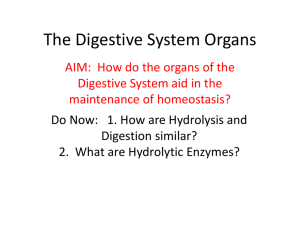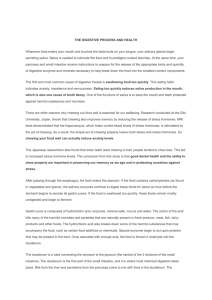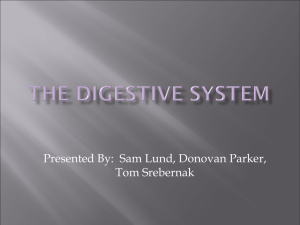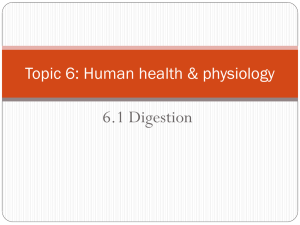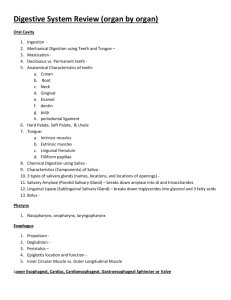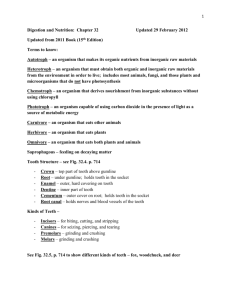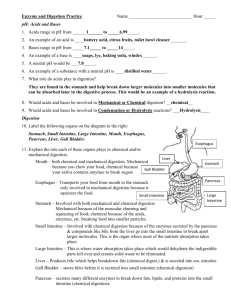The Digestive System Organs
advertisement
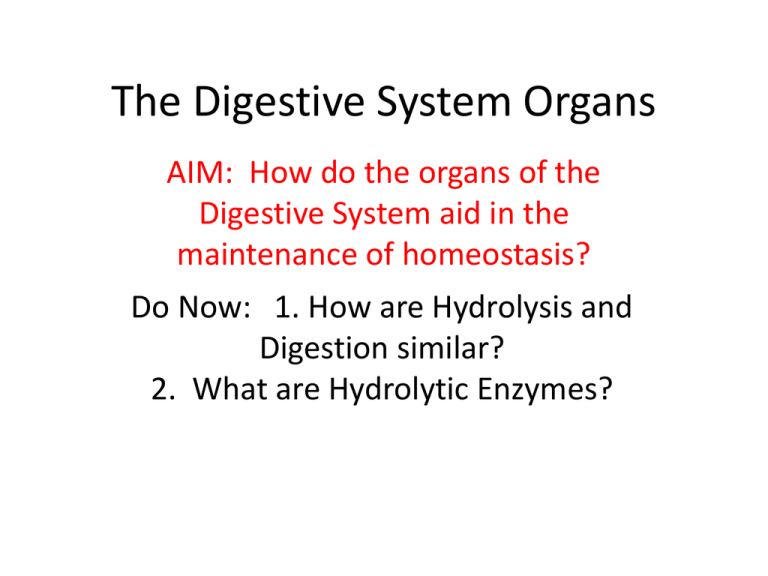
The Digestive System Organs AIM: How do the organs of the Digestive System aid in the maintenance of homeostasis? Do Now: 1. How are Hydrolysis and Digestion similar? 2. What are Hydrolytic Enzymes? Hydrolysis and Digestion • Both are processes involved in breaking down substances. • Hydrolysis: addition of water to break substances down • Digestion: Breakdown food into nutrients Hydrolytic Enzymes • • • • Enzymes involved in the process of hydrolysis Enzymes that speed up the rate of hydrolysis Enzymes that break things down ALL DIGESTIVE ENZYMES ARE HYDROLYTIC Organs of the Digestive System 1. The MOUTH/ ORAL CAVITY Teeth Chew – Increases Surface Area – Mechanical Digestion. Salivary glands: produce Saliva that contains amylASE (enzyme)– starts the chemical digestion of Starch (carbs) Pharynx, Trachea, and Epiglottis Pharynx: Throat Trachea: Windpipe for air only Epiglottis: flap of tissue that protects trachea from food or liquids. Esophagus : Food/ Liquid Tube • Connects the pharynx to the stomach. • Food is pushed through the esophagus by Peristalsis. Peristalsis: wavelike muscular contractions of the smooth muscle that lines the digestive system that push food through the esophagus and intestines. Peristalsis Diagram Stomach J-shaped organ that contains Gastric Juice. Temporary holding tank for food to mix Churning: Mechanical Digestion Gastric Juice: Contains Hydrochloric Acid and Proteases which begins the chemical digestion of proteins. Material is now called CHYME ACCESSORY ORGANS: Liver, Gall Bladder and Pancreas Liver: Makes a substance called BILE. Gall Bladder: Stores a substance called BILE. So – What is Bile? BILE Bile contains bile acids, which are critical for digestion and absorption of fats Bile does not contain enzymes: Mechanical Digestion All Bile does is EMULSIFICATION: Breaks large fat globules into smaller fat droplets PANCREAS Makes Pancreatic Juice: Contains many ENZYMES that will chemically breakdown Carbohydrates, Lipids, and Proteins. This juice gets secreted into the first part of the small Intestine through the pancreatic duct. SMALL INTESTINE First Part of the Small Intestine is called the DUODENUM: This is where most chemical digestion occurs. WHY? The duodenum is the first part of the small intestine. It is located between the stomach and the middle part of the small intestine, or jejunum. After foods mix with stomach acid, they move into the duodenum, where they mix with bile from the gallbladder and digestive juices from the pancreas. These CONTAIN ENZYMES!!!!!!!!!!! This is where most chemical digestion occurs: the Chemical digestion of proteins fats and carbs occurs here AFTER THE DUODENUM ALL DIGESTION ENDS AND ABSORPTION OF MATERIALS BEGINS!!!!!!!! Second part of the Small Intestine This is where absorption of nutrients occurs. HOW? Through Structures called Villi VILLI • Increase the absorptive surface of the Small Intestine for maximum absorption of material. • Contain Capillaries so material can diffuse into the bloodstream. • Contain Lacteals for the absorption of fats. (Capillaries are blood vessels that are microscopic where diffusion of materials occurs) Large Intestine • Reabsorption of water occurs and the formation of feces (solid waste: material not completely broken down or absorbed.
